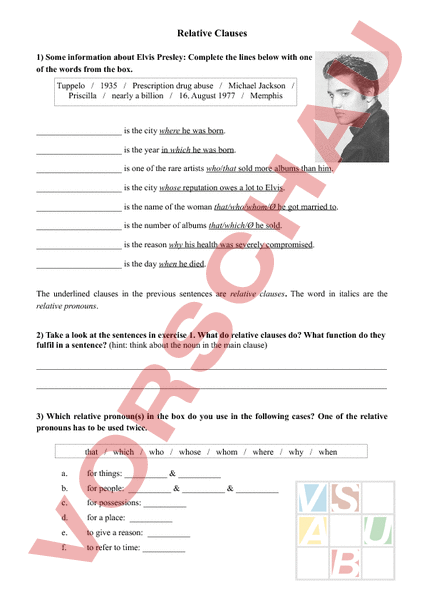Arbeitsblatt: Relative Clauses
Material-Details
Ein Handout in dem Lernende angeleitet werden, die Regeln die dem Gebrauch von relative clauses unterliegen zu entdecken, kombiniert mit einigen kurzen Übungen.
Englisch
Grammatik
10. Schuljahr
2 Seiten
Statistik
110598
1041
9
24.01.2013
Autor/in
Daniela Rohrbach
Land: Schweiz
Registriert vor 2006
Textauszüge aus dem Inhalt:
Relative Clauses 1) Some information about Elvis Presley: Complete the lines below with one of the words from the box. Tuppelo 1935 Prescription drug abuse Michael Jackson Priscilla nearly billion 16. August 1977 Memphis is the city where he was born. is the year in which he was born. is one of the rare artists who/that sold more albums than him. is the city whose reputation owes lot to Elvis. is the name of the woman that/who/whom/Ø he got married to. is the number of albums that/which/Ø he sold. is the reason why his health was severely compromised. is the day when he died. The underlined clauses in the previous sentences are relative clauses. The word in italics are the relative pronouns. 2) Take look at the sentences in exercise 1. What do relative clauses do? What function do they fulfil in sentence? (hint: think about the noun in the main clause) 3) Which relative pronoun(s) in the box do you use in the following cases? One of the relative pronouns has to be used twice. that which who whose whom where why when a. for things: b. for people: c. for possessions: d. for place: e. to give reason: f. to refer to time: 4) In the following sentence, the relative pronoun cannot be omitted: I. The car that was stolen was Mercedes. Wrong: The car was stolen was Mercedes. In this sentence, the relative pronoun that is the subject of the relative clause: that was stolen It was stolen. In the following sentence, the relative pronoun can be omitted: V. The people whom/who work with are all lot older than me. Or: The people work with are all lot older than me. Here, the relative pronoun whom is the object of the relative clause: whom work with work with them. Daniela tips and tricks 101: If the relative pronoun who, which or that is followed by pronoun or the name of thing/person, the relative pronoun can be omitted. In all other cases, the relative pronoun cannot be omitted. 5) In which of the sentences in exercise 1 can the relativ pronoun be omitted? 6) Decide whether the following sentences are correct. Correct the sentences where necessary. a. That the girl spoke to me yesterday. That the girl that/who spoke to me yesterday. b. The man who smoked forty cigarettes day died of heart attack. OK c. That the dog whose owner is French. d. The woman lives next door is doctor. e. met man car had broken down. f. What the name of the book you wanted to read to me?
